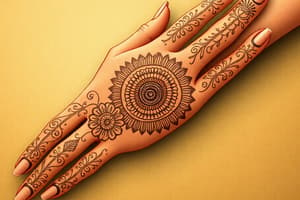Podcast
Questions and Answers
The henna plant has been used to decorate the body for thousands of ______.
The henna plant has been used to decorate the body for thousands of ______.
years
The earliest evidence of henna comes from Egyptian ______ stained with henna.
The earliest evidence of henna comes from Egyptian ______ stained with henna.
mummies
Henna was used widely in the Roman Empire, Ancient Egypt, North ______, and the Arabian Peninsula.
Henna was used widely in the Roman Empire, Ancient Egypt, North ______, and the Arabian Peninsula.
Africa
People in the desert have used henna for ______.
People in the desert have used henna for ______.
The henna leaves are collected, ground into a ______, and mixed with other ingredients.
The henna leaves are collected, ground into a ______, and mixed with other ingredients.
Henna paste is typically left on the palms and soles of the feet for its ______ effect.
Henna paste is typically left on the palms and soles of the feet for its ______ effect.
Henna is used for special occasions such as weddings, engagements, and ______.
Henna is used for special occasions such as weddings, engagements, and ______.
The most popular tradition is the ______ Night, where the bride and her family celebrate an upcoming wedding.
The most popular tradition is the ______ Night, where the bride and her family celebrate an upcoming wedding.
Tradition suggests that as long as the henna ______ appears on the bride, she doesn't have to do any housework.
Tradition suggests that as long as the henna ______ appears on the bride, she doesn't have to do any housework.
The darker the stain, the better the ______!
The darker the stain, the better the ______!
Study Notes
History and Cultural Significance
- Henna plant has been used for body decoration for thousands of years, with evidence found on Egyptian mummies.
- Flourished in various cultures including Ancient Egypt, Roman Empire, North Africa, Arabian Peninsula, and Asia.
- Served as an affordable adornment for the poor and a luxury for the wealthy.
Traditional Uses and Preparation
- Henna leaves are collected and ground into a paste to be mixed with warm water, lemon juice, tea, sugar, and essential oils.
- Primarily used for cooling effects upon initial application, leaving a stain on skin post-removal.
- Can be used to dye leather, silk, wool, and hair in addition to body decoration.
Celebratory Practices
- Traditionally used for special occasions such as weddings, engagements, and Eid celebrations.
- Henna Night: A significant event where the bride and her loved ones gather to celebrate an upcoming wedding.
- Bridal henna designs can vary from simple shapes to intricate geometric patterns and may take hours to complete.
Symbolism and Beliefs
- Duration and darkness of the henna stain symbolize good luck in marriage, with the belief that a darker stain indicates a stronger relationship.
- Tradition states that as long as the henna stain remains, the bride is exempt from certain household duties, reflecting the importance of the ritual in cultural narratives.
Studying That Suits You
Use AI to generate personalized quizzes and flashcards to suit your learning preferences.
Description
Explore the rich history and cultural significance of henna, a plant used for body decoration for thousands of years. Discover its traditional preparation methods and celebratory practices, especially during weddings and special occasions. Learn about its uses across different cultures and social classes.




